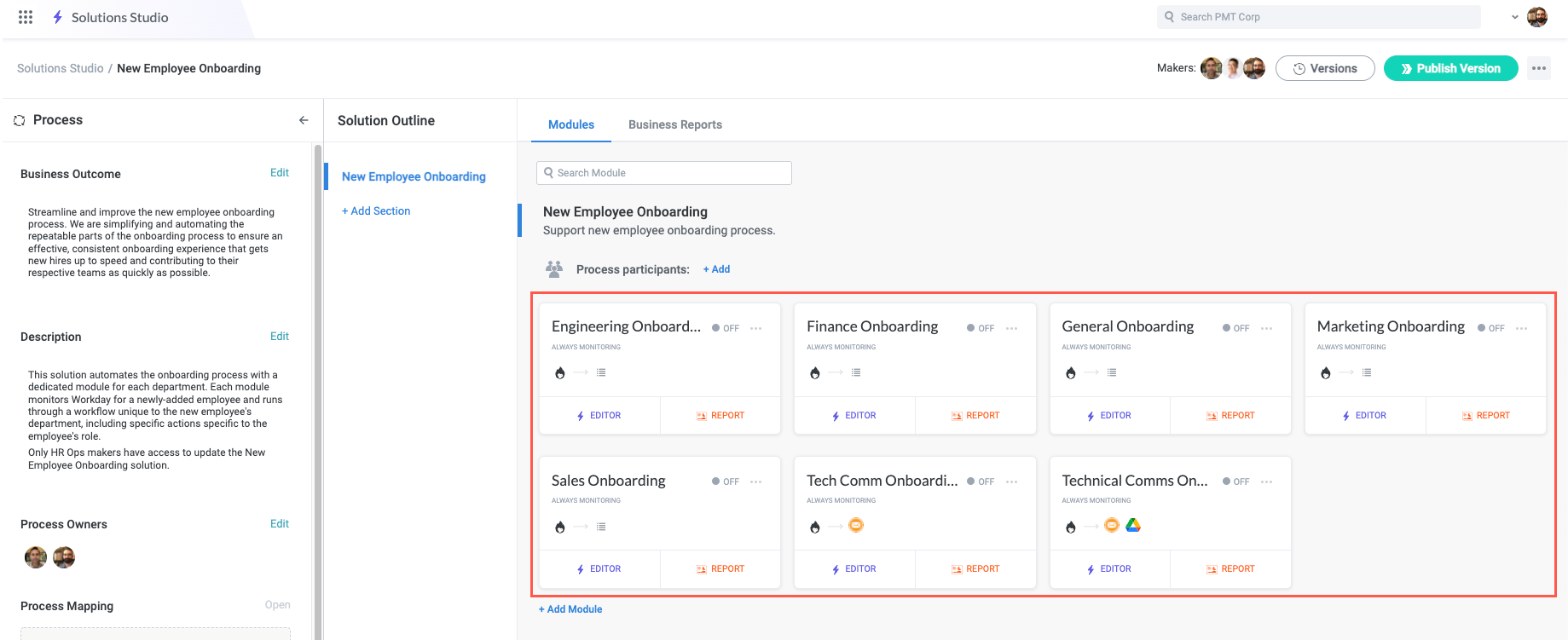2. Tonkean Foundations - Solutions
The solution is the core of the Tonkean platform. It encompasses all the work your team does to solve a business problem, from identifying the problem and desired outcome, to building the individual modules—with all the required data and logic—that work to solve that problem.
For common request intake and resolution processes, for example, a solution might include a module for each intake source (Slack, email, and so on) and a single module that handles the triage and coordination of each request. All these modules work together to solve a single, often complex, business problem.
The solution provides a framework for effectively understanding your process and how to collaboratively orchestrate it, allowing space for continued iteration and enhancement. Simply put, the solution is where the most important work in Tonkean happens.
The Solution in the Build Process
Because the solution is an integral part of the Tonkean experience, it's important to understand how you leverage the solution throughout the different stages of solving a business problem. As an example, let's look at what the process might look like for an HR Ops team as they build a solution for new employee onboarding from scratch.
An alternative approach, and increasingly one we recommend to most users, is to start with a solution blueprint from our Component Library and customize it to your needs.
Currently, new employee onboarding is handled by each individual team in a largely manual fashion, and as the company has grown, it has become difficult to ensure a consistent and effective onboarding experience for all new employees. This inconsistency leads to some new hires taking much longer than others to onboard and begin contributing in their new roles—this is the core business problem HR Ops wants to solve.
With a clear understanding of the business problem, the makers in HR Ops create a new solution, New Employee Onboarding that will handle onboarding for all the relevant departments, streamlining and simplifying the process. In their new solution, they define the target business outcome and description of the solution.

Once they have the desired outcomes established, HR Ops starts building the modules. Because each department has unique needs and processes, the makers build a dedicated module for each department, designing a unique experience for each team. The HR Ops makers work with the hiring managers for each department to understand their unique onboarding processes and design a tailored module for each one. And as they build, they refer back to the desired outcomes they defined to ensure the team stays aligned—refining and iterating on the solution description as they work.

After the modules are up and running, and the HR Ops makers are able to track important metrics and statuses in the relevant business reports, the solution remains the source of truth for HR Ops as the business processes inevitably change or they find new avenues for improvement. This is one of the great strengths of the solution in Tonkean: it's a dynamic, changing entity that's designed to shift with the changing landscape of your business.
At a high level, this is how the solution looks for many teams, especially shared-services teams like HR Ops. Working in a similar fashion, you can leverage the solution to build an experience tailored to your specific users, serving your various teams while maintaining control over the important parts of the process.
Solutions Provide Visibility and Insight
More than a space exclusively for makers to build and iterate, the solution can act as the external face of your team's achievement and continued efforts. Because it represents and contains the end-to-end process that addresses your specific business problem, it's a natural artifact of process orchestration and management that the wider organization can understand.
After all, most solutions are providing an experience for those outside the implementation team, so there are likely other people in the organization benefiting from the solution without even realizing it.
Similarly, the metrics and statuses tracked in the solution can provide important data to those outside the team of makers, allowing the larger organization to both celebrate the implementation's success and gain important insight into the continued management of the process.